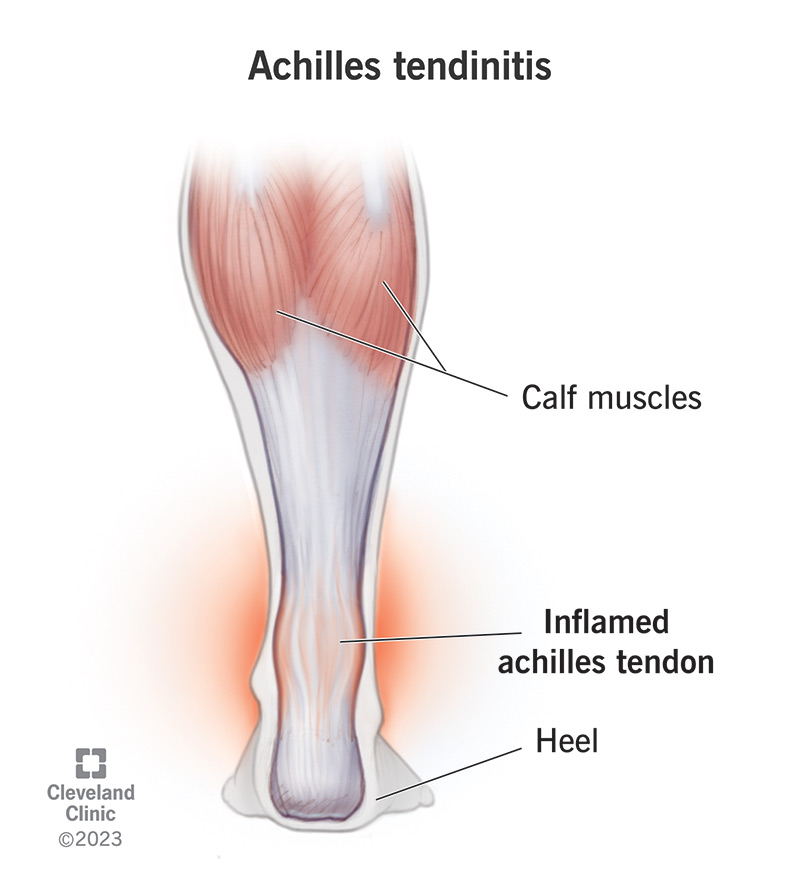Your Achilles tendon connects your heel bone to your calf. If it’s overly stressed, you can get Achilles tendinitis, the main cause of Achilles tendon pain. If untreated, it can lead to an Achilles tendon rupture. Achilles tendinitis treatment includes rest, physical therapy and supportive shoes. You may need surgery if the symptoms don’t go away.
Advertisement
Cleveland Clinic is a non-profit academic medical center. Advertising on our site helps support our mission. We do not endorse non-Cleveland Clinic products or services. Policy

Achilles tendinitis (also spelled tendonitis) is inflammation of the tissue that connects your calf muscle to your heel (Achilles tendon). Inflammation is your body’s response to injury or disease. Achilles tendinitis is a common condition in runners. When you run, your calf muscles help raise you up on your toes. Over time, this repetitive motion, combined with not giving your body enough time to rest, can cause painful inflammation.
Advertisement
Cleveland Clinic is a non-profit academic medical center. Advertising on our site helps support our mission. We do not endorse non-Cleveland Clinic products or services. Policy
The two types of Achilles tendinitis describe the affected part of your tendon:
Achilles tendinitis is a common condition. It most often affects active people and athletes. About 24% of athletes will develop an Achilles tendon injury in their lifetimes.
Achilles tendinitis symptoms affect the back part of your lower leg above your heel. You might notice:
You may notice more discomfort:
With Achilles tendinitis, overuse of your Achilles tendon causes swelling, irritation and inflammation. You can get Achilles tendinitis by being active on your feet. It’s usually not related to a specific injury — it happens because of stressing your tendon repeatedly. Because it’s difficult to avoid using your Achilles tendon, your body doesn’t have time to repair the injured tissue.
Advertisement
Achilles tendinitis is a common sports injury. People at high risk for Achilles tendinitis include those who:
You may also be at higher risk for Achilles tendinitis because of your anatomy (body shape and structure). For example, if you have:
If you don’t rest or seek treatment for Achilles tendinitis, you may experience the following complications:
Your healthcare provider will ask you about your symptoms and recent activity. They’ll perform a physical examination and look for signs of Achilles tendinitis or Achilles tendon rupture. They’ll check your range of motion and look for signs of bone spurs.
Your provider can often diagnose Achilles tendinitis based on the physical exam alone. You may need imaging to show the condition’s details or severity. Imaging exams may include:
Your healthcare provider will first recommend nonsurgical treatment. It may take a few months for the pain to get better — especially if you’ve already had symptoms for a few months.
Nonsurgical Achilles tendinitis treatments include the RICE method:
Protect your tendon. Avoid walking up steep inclines or overstretching your tendon, such as by standing on a ladder rung. Wear:
Advertisement
Other nonsurgical Achilles tendinitis therapies that can help include:
If you’ve tried nonsurgical methods for six months and you’re still in pain, talk to your provider. You may need surgery. A foot and ankle surgeon can suggest options based on your injury, age, preferences and activity level.
Surgical options include:
Advertisement
Some people still experience pain after surgery. The other complication that can occur is a wound infection. Infections can be challenging to treat because of the location of the Achilles tendon.
People can recover from Achilles tendinitis. But get treatment as soon as you feel symptoms. The longer you live with the pain, the harder and longer the treatment process will be.
Most people have good results from Achilles tendinitis surgery. The factor that affects your recovery is how much of your tendon has damage. People with a lot of tendon damage need a longer recovery time.
Physical therapy plays a big role in your rehabilitation, either as a treatment method or as part of your recovery from surgery. It can help you regain your strength and function.
To reduce your risk of Achilles tendinitis:
Advertisement
If you notice symptoms of Achilles tendinitis, such as pain, stop what you’re doing and rest. Then, talk to your healthcare provider about next steps.
Achilles tendinitis can be frustratingly slow to heal. It can take time for your symptoms to disappear completely. Follow your healthcare provider’s instructions so you don’t reinjure the tendon and worsen the symptoms.
If you’re trying nonsurgical treatments to avoid or delay surgery, expect to wait a few months to see improvement. To keep your tendon healthy:
If you’re recovering from surgery, follow your provider’s instructions for the recovery period:
Call your provider or go to an urgent care center if you have:
If you have Achilles tendon pain or Achilles tendinitis, ask your provider:
Achilles tendon pain is common in athletes and active people. If you have Achilles tendon pain, talk to your healthcare provider. The longer you wait to take care of it, the longer it takes to treat. You can treat Achilles tendinitis using nonsurgical methods, such as avoiding certain activities, using custom orthotics and attending physical therapy. If nonsurgical treatments don’t provide relief, talk to your provider about surgery for Achilles tendinitis.
Cleveland Clinic experts are here to treat your tendinopathy (tendon pain) and get you back to doing the things you love.

Last reviewed on 03/06/2024.
Learn more about the Health Library and our editorial process.